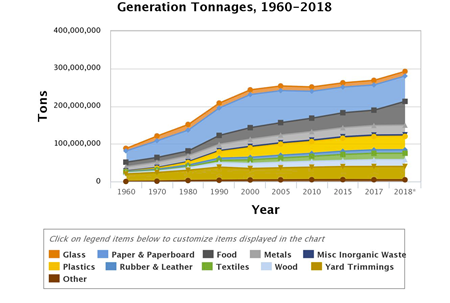Earth Day Guide to Reduce Waste

This Earth Day Guide summarizes ways you can reduce waste and celebrate Earth Day each and every day. Humans impact the Earth in many ways, but our waste is one of the most meaningful impacts. According to 2018 numbers from the EPA, each American throws away 4.9 pounds of waste per day! In this guide, we explore ways to improve the quality of our world by reducing waste and pollution on behalf of Earth Day 2022.
When did earth day start?
In the mid-20th century, industrial America was booming. The economy was soaring. But the environment was suffering. In the years before Earth Day, air pollution, noise pollution, and waste were a commonly accepted way of life with little thought to the potential effects of it on both people and the environment.
As time went on, people began to grow concerned about our impact on the planet. After a terrible oil spill the year before, a senator from Wisconsin sparked the idea. With the help of others, the first Earth Day was held on April 22, 1970.
It was a day where the American people came together to clean streets, pick up trash, and ignite the modern movement of environmentalism. Before this time, waste and the environment weren’t at the forefront of many people’s minds, but this started the conversation. Though it was only 10% of the population who participated on this day, it totaled to approximately 20 million people coming together and trying to make a difference by cleaning up the world around them. After a seemingly successful inauguration for Earth Day, the rest is history!
Earth Day 2022
The Earth Day 2022 theme is Invest in our Planet. “This is the moment to change it all — the business climate, the political climate, and how we take action on climate. Now is the time for the unstoppable courage to preserve and protect our health, our families, our livelihoods… together, we must Invest In Our Planet.”
The resources and events promoted on EarthDay.org are part of a year-round effort, as they put it:
“Today’s the day to TAKE ACTION not just because you care about the natural world, but because we all live on it. Every one of us needs a healthy Earth to support our jobs, livelihoods, health & survival, and happiness. A healthy planet is not an option — it is a necessity.
Growing out of the first Earth Day in 1970, our mission is to diversify, educate, and activate the environmental movement worldwide, all year long.”
We encourage you to participate in an event near you and find ways to #InvestInOurPlanet at work, home, and your community. This year Reduction In Motion will be facilitating events throughout Earth Month at many of our client sites including medical supply donations, tree plantings, information tables, seed and compost give-a-ways, shredding events, and more.
How much waste do Americans throw Away?
Even as the world becomes more modernized, advanced, and efficient, trash generated by humans continues to rise. The amount of waste Americans have been throwing away has risen consistently since 1960, according to the EPA.

Today, each American generates 4.9 pounds of waste each day…that’s 1,788.5 pounds each year! The waste a couple throws away each year weighs more than a Honda Civic!
Why reduce waste?
Everyone produces waste, so we all have the same opportunity to reduce it. If waste is not recycled or composted it is sent to a landfill or incinerated… sometimes shipped across the United States or even the globe before doing so. While landfill space in the US is decreasing at an alarming rate, the environmental impact of generating waste is more than just the space occupied by growing landfills. The true impact includes all the carbon emissions associated with creating disposal products, transporting those products, using those products, transporting it as waste, and processing that waste before it is either placed in a landfill or incinerated.
Once waste is placed in a landfill or incinerated, it is a lost resource. Much of the waste placed in landfills or incinerated can be recycled, composted, or reduced altogether.
How to recycle properly?
Recycling is a great first step to reducing waste, but we need to recycle right! With different recycling guidelines from community to community and business to business… recycling right can be a challenge…
But let’s make it simple!
Most Americans recycle, but many are shocked to find some of the materials they regularly put in their recycling bin are considered contamination. For instance, if you put your recycling in a plastic bag… all that recycling could be thrown out as trash because plastic bags often jam the sorting machines at the recycling facility!
The first step to recycling right at home is researching your local county or state department of waste to find out what is accepted for recycling near you. To figure out what can be recycled at work, your company will need to ask their recycling hauler what they accept. If your company doesn’t have a recycling dumpster then, unfortunately they’re not recycling at all.
Don’t wishcycle! What is wish-cycling? Wish-cycling is when you throw an item into the recycling bin that you’re not sure is recyclable but hope it ends up being recycled. This doesn’t help! A little contamination can result in a truckload of good recyclables being rejected and thrown out as trash!
Here are some commonly accepted items for recycling and composting. But remember to do some research on what is accepted as recycling before throwing things in your recycling bin at work or home!
Recycling
Items commonly accepted in curbside or commercial recycling programs:
- #1 & #2 plastic bottles and containers
- Cardboard boxes
- Chipboard boxes
- Paper and magazines
- Aluminum cans
We recommend confirming with your specific hauler if the following are accepted as recycling:
- Milk cartons
- Glass jars and bottles
- Pizza boxes
- #3 – #7 plastic items
Common items that are confused as recycling (but are not):
- Paper food products (cups, plates, napkins, and paper towels)
- Items contaminated with food or beverages (best to dump out and lightly rinse)
- Metal items that aren’t cans
- Soft plastics like plastic bags, wrap, and wrappers
Special drop off locations for recycling items:
- Household hazardous waste (most local governments have a drop off location or annual events)
- Plastic bags (can be taken to most grocery stores)
- Light bulbs (can be taken to most home improvement stores or local drop off locations)
- Batteries (can be taken to some local drop off locations)
- Appliances (can be taken to some local drop off locations)
Composting
Composting is when you take any organic matter and put it through a process in which it decomposes naturally. This naturally decomposed substance can then be used as soil fertilizer. Composting has a multitude of sustainability benefits and in recent years, it has been found that approximately 39% of all waste is compostable.
You can start composting at your home but there is also a growing list of local organics haulers for your workplace, residential composting containers provided by governments, or drop off sites for residents to bring their compostable materials to.
Common items that can be composted:
- Leaves
- Non-meat and dairy food scraps like eggshells, banana peels, and leftovers
- Coffee grounds
- Tea bags (but best to remove any metal staples!)
Items that can be composted at some sites but not in a backyard or small-scale operation:
- Meat and dairy food scraps
- Untreated Grass
- Compostable dinnerware
Ways to reduce waste every day

Whether you have started recycling and composting or not, there are other important things that you can do in your everyday life to help prevent waste and keep waste out of landfills:
Reusable Water Bottles
Plastic water bottles are not only a huge contributor to waste, but they are less cost-effective than reusable water bottles. If you want to save money while also reducing waste, try buying your own reusable water bottle.
Reusable Coffee Cups
Coffee is another staple that many people have almost every day. If you are frequently buying coffee or making coffee for yourself, consider getting and keeping a reusable coffee cup. While you may already do this when you are at home, some may not consider doing this while they are out, running to grab a coffee with a friend or getting some coffee on their way into work. Some eateries even offer a deal on coffee when you bring your own reusable cup!
Bring Your Own Grocery Bags
Plastic grocery bags are mass produced and contribute to a great deal of waste and litter. Even though paper bags and/or compostable bags are often considered a better option, the best option is bringing your own fabric grocery bags.
Reusable Food Service Ware
Reusable Tupperware, silverware, and straws are a great place to start for reducing waste when it comes to eating out or doing take out! If you’re eating out, bring your own Tupperware to take home any leftover food you may have. This reduces both food waste and plastic waste. If you are partial to using a straw, consider bringing a reusable straw with you to avoid using a single use straw. Next time you do takeout, consider asking for no utensils and use your own instead!
Go “Paperless”
Paper is recyclable, but if you are looking to reduce all forms of your waste and try your best to reduce your carbon footprint, consider going “paperless.” You can do this in a lot of ways. The quickest way to go “paperless” is to opt into paperless billing that many companies have these days. Other smaller ways include sending evites for parties and events instead of paper mail; taking notes on a phone, tablet, or computer; or reading e-books instead of purchasing physical books.
Buy Second Hand
Buying second hand is a great way to reduce waste, while also potentially saving some money! Purchasing used items extends the lifespan of an item by preventing it from ending up in a landfill. This keeps items in circulation for longer and prevents the need for new items to be created, resulting in less resources being used to create new items. You can shop for secondhand items in-person at consignment or thrift stores, or online through a variety of websites that focus on purchasing and selling used goods and clothing.
Buy Less
One step even better to buying second hand is to simply buy less stuff. The fewer items that are bought, the fewer items that will be thrown away. While you don’t have to go to the extreme, it may be worth a try to simply evaluate whether or not you truly need something the next time you go to the store. When in doubt, hit the pause button and give it a few days allowing you time to determine if something will contribute to clutter or if it’s useful.
Buy in Bulk
When grocery shopping, a great way to reduce your waste is to buy items you typically purchase in bulk. When buying in bulk, some stores allow customers to bring their own containers to fill, which reduces waste by eliminating a disposable plastic container. If grocers do not allow customers to bring their own containers or simply don’t have a section like that, buying the bigger version of your favorite item can also help eliminate waste.
Recycle Food Containers
When buying items at the grocery store, try picking items that come in either easily recyclable materials (such as cardboard) or materials that can be reused in your home, such as glass. For example, if an item comes in a glass jar, you can reuse and repurpose this jar once it is empty to store other items!
Shop Consciously
Lastly, be a conscious consumer by “voting with your dollar” and shop at stores, companies, and businesses that prioritize being sustainable and having a positive environmental impact. This is a great way as a consumer to reduce your waste and be more sustainable since you are supporting businesses whose values align with yours. Small steps like this can have a big impact!
How to make a difference this Earth Day and beyond
When most people realize our waste problem, it is often met with doom and gloom. How will we ever reduce all this waste! While the waste and sustainability problems facing the United States (and the world) are quite frightening, the fear should not be the focus.
By focusing on the negative, people often feel overwhelmed. Huge overwhelming numbers can feel like there’s no point in trying to help because there’s absolutely no way that you could make a considerable difference. But that just simply isn’t the case.
While waste is still a huge issue, we are becoming more aware of how to responsibly dispose of our waste, and the list of resources, tools, and programs to help us is growing!
Here are some simple questions to ask yourself and your company to get started:
- Do you recycle at home? Does your company recycle?
- Do you know what is accepted for recycling at your workplace or home?
- Does your company know its recycling rate?
- Are there signs or labels at your workplace that help you separate waste, recycle, or compost?
- Are you trained on how to separate waste or be environmentally sustainable at work?
- Could your business benefit from a waste audit?
- Do you or your company have an opportunity to reduce waste by using reusable items?
- Does your company have a green team?
- Are you doing anything at work, home, or in your community for Earth Day?
This Earth Day… do your part and adopt or improve a habit that reduces your waste and helps our planet!
If your company could use help reducing their waste, reach out any time to the team here at Reduction In Motion.
Happy Earth Day!
The Reduction In Motion Team

Our team of sustainability and waste consultants work together to develop content for our site. Contact us to learn more about something we’ve written about or would like us to focus on in the future.

